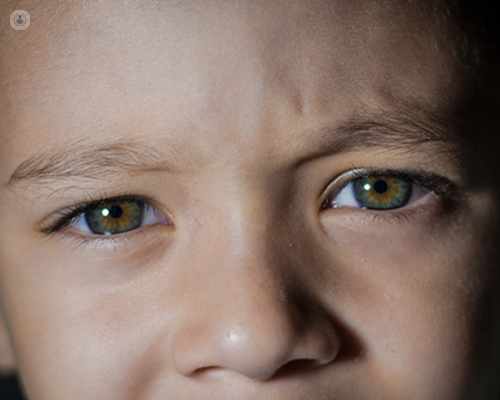Should I worry if my child's pupils are of different size?
Written by:It goes without saying that our pupils are an incredibly useful part of our eyes because of how they automatically adjust to light, allowing us to adapt to our environment in an instant. However, it’s possible that they are different sizes. Is this something to be concerned about if you notice it in your child?
Dr Annegret Dahlmann-Noor, director of the children’s eye service at Moorfields Eye Hospital, London, discusses this issue in this informative article for parents and carers. Read on to find out more.

What is the pupil, and what does it do?
The pupil is the ‘hole’ in the centre of the iris, the blue/brown part at the front of the eye. The iris is a ring-shaped muscle - more precisely, it contains two muscles, one to make the pupil bigger, and the other to make the pupil smaller. By changing the pupil size, light more or less enters the eye. In a dark room, the pupils become bigger to let more light in, so we can still see. In bright light, the pupils become smaller so the light doesn’t dazzle us. The pupil also becomes smaller when we focus on something close-up, thereby helping the eye to focus an image onto the back of the eye.
Why causes a difference in pupil size?
Many people have a difference of up to 1mm between the two pupils. This difference is the same, regardless of whether they are in a dark room or in bright light. This difference in pupil size is not linked with any underlying condition.
Some people have a difference in pupil size from birth, particularly if forceps were used during delivery. Pulling on the baby’s head during birth can damage the delicate nerve fibres in the neck which send signals to the muscle in the iris which dilates the pupil. The same nerve fibres also travel to the eyelids. When they are damaged, the pupil on the affected side is smaller, which is particularly noticeable in a dimly lit room. The distance between upper and lower lid is also smaller than on the other side. This condition is called ‘congenital Horner syndrome’. In some children, the iris colour can also be lighter on the affected side, or the child may have a blue iris on the affected side and a brown iris on the other side.
Horner syndrome in children can also be a sign of a serious underlying condition, a tumour called neuroblastoma. Neuroblastoma most commonly affects children in the first five years of life. It can develop in different parts of the body, most commonly in the adrenal glands which sit on top of the kidneys. Children with neuroblastoma do not have a difference in pupil size from birth, but can develop it during the first few years of life.
Another cause for a difference in pupil size in children is an inflammation of the nerve fibres which send signals to the iris muscle which makes the pupil smaller. This inflammation can happen during or after a viral infection. The affected pupil is bigger than the other pupil, and it constricts slowly in bright light, more slowly than the other pupil. This is called an ‘Adie’ or ‘Holmes Adie’ pupil.
Brain tumours or other brain conditions are rare causes of a difference in pupil size. Pressure on the nerves, which send signals to the iris muscle to make the pupil smaller, cause a dilated pupil on the affected side. Children with acute brain conditions tend to have other symptoms, such as:
- Nausea
- Vomiting
- Headaches
- Changes in behaviour
- Lethargy
- Sleeplessness
Lastly, different types of medications can cause a dilated pupil in children. Some inhalers such as ipratropium bromide or salbutamol can dilate the pupil, and also scopolamine/hyoscine patches which are used for travel sickness, or to reduce drooling in severely disabled people. If any of these are in the house, even if for other family members, a child may get hold of them and transfer the medication to the eye with their fingers. And children may, of course, also be on treatment for amblyopia (‘lazy eye’) with atropine eyedrops, which dilate the pupil.
When should I take my child to see an ophthalmologist?
All children with a difference in pupil size of more than 1mm, which has developed after birth should have an assessment by an eye doctor specialising in children’s eye conditions. If there is an acute onset, then the child should be seen urgently.
However, in most children the difference in pupil size is very small and noticed by chance. In these cases, a consultation with an eye doctor can provide re-assurance that an underlying condition is unlikely. A difference in pupil size does not affect the child’s visual development.
Arrange a consultation with Dr Dahlmann-Noor to address any concerns you may have regarding your child’s eye health, via her Top Doctors profile.


